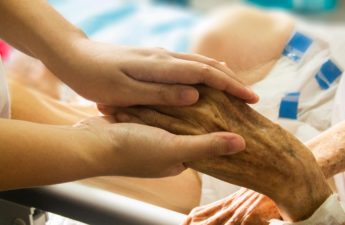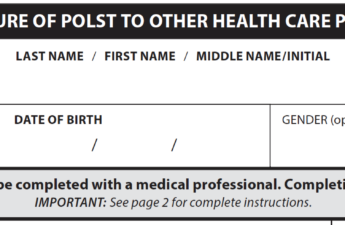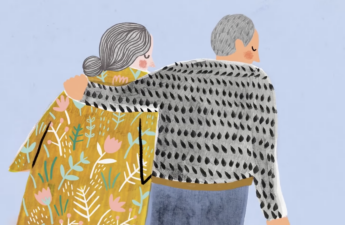‘My Soul and My Role Aligned’ — How Hospice Workers Deal With Death
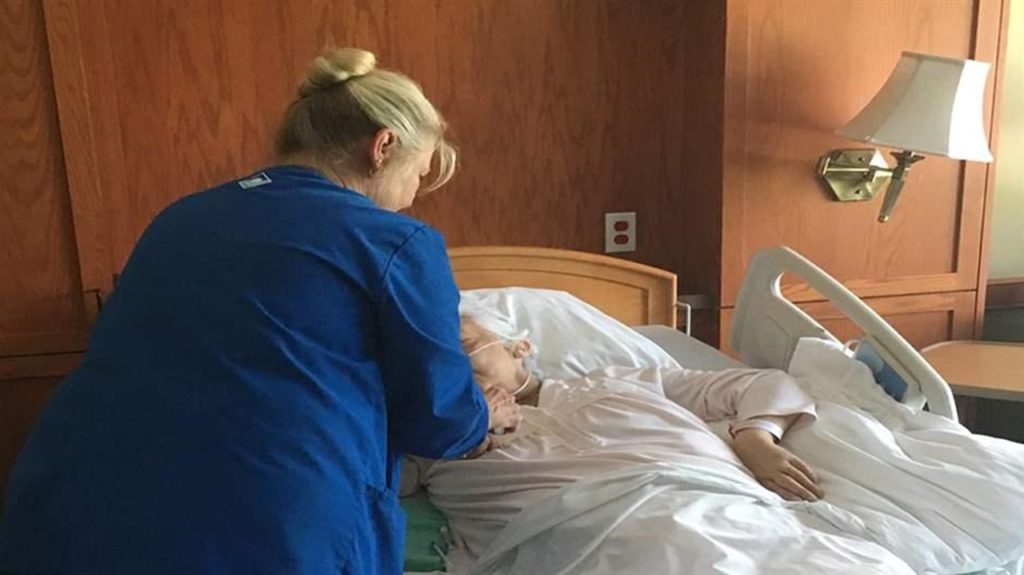
CLEVELAND — It is 7:30 on a summer morning in a chapel-like room overlooking the slate-gray, lapping waters of Lake Erie. Ten or so people, some just arriving at work, some finishing a night shift, sit silently in pew-like benches and armchairs below stained-glass windows. A plump Golden Retriever named Linus, a hospice therapy dog, wanders from one person to another, gratefully accepting their caresses.
Dr. Kevin Dieter, a hospice care physician with graying mustache and goatee, gently suggests they get started. A hospice nurse sitting in a bench opposite him begins reading names. In the pause after she pronounces each, Dieter strikes together two palm-sized Buddhist meditation chimes, producing a tinkling peal that quickly evaporates. The names go on and on. Evonne and Molly and Andre and Jerry. Twelve in all.
Twelve patients who were alive in this hospice house three days ago when this ceremony was last held. Twelve who have died since, each in one of the bedrooms lining the quiet hallways, each having hoped for a death free of pain or distress and, for the lucky ones, bitterness or resentment.
Providing the possibility of that wished-for death is the professional mission of all in this room, of all the 935 employees and 3,000 volunteers who work for the 40-year-old nonprofit Hospice of the Western Reserve.
Each day they serve 1,200 hospice patients, most of them in hospitals, nursing homes, or their homes, and as many as 88 in one of three inpatient hospice houses in the Cleveland area, like this one off Lakeshore Boulevard.
By Medicare’s criteria, to receive hospice services, each of those patients is deemed to have six months or less to live. In most cases, they also must agree to forgo curative treatments.
All the employees will say they’ve gotten used to hearing The Questions, from family and friends, even from the loved ones of patients they care for. “We get asked that all the time,” said Tammy Wright, 43, a nurse’s assistant with hospice certification, now in her ninth year doing hospice work. “Why did you ever choose to work there? Why would anyone elect to spend their workdays so entwined with death and grief? And how can you possibly get up the next morning to do it all over again?”
It is hard to think of another profession with such constant exposure to dying. Yet, as intense and exhausting as hospice care is, you seldom hear any of the doctors, nurses, aides, social workers and bereavement counselors at the Hospice of the Western Reserve describe the job as grim, sad or dispiriting. Instead, they tend to portray the work as deeply fulfilling, gratifying and, perhaps most counterintuitively, life-affirming. And in working in the presence of imminent death, they all say they have witnessed sights that defy expectation or explanation.
“We see God working here all the time,” said Dee Metzger, 68, a hospice nurse in the Medina Inpatient Hospice Care Center southwest of Cleveland. “All the time.”
The turnover rate among employees at Western Reserve is a surprisingly low 12 percent, according to Judy Bartel, Western Reserve’s chief clinical officer. (Nationally the turnover rate for hospice registered nurses is almost 19 percent.) To retain its employees, the hospice offers them many outlets to combat burnout and “compassion fatigue.”
As more Americans opt for hospice care, keeping hospice workers dedicated, replenished and content is a growing concern. The number of hospice patients grew 167 percent between 2000 and 2016, to more than 1.4 million, according to a March 2018 report from the Medicare Payment Advisory Commission, which provides Congress with analyses regarding Medicare. Nearly half of Medicare beneficiaries who died in 2015 had received hospice services.
At Western Reserve, those who quit the job are the ones who can’t leave the work behind when they head home.
“It’s sacred work,” says Lisa Scotese Gallagher, one of whose jobs at Western Reserve is to provide programming to help the staff deal with the stress and emotional intensity of their jobs. “But the expectation that we can be immersed in suffering and loss and not be touched by it is unrealistic.”
‘My Soul and My Role Aligned’
Every week, Dieter loses 10 to 20 patients. Even those who survive the week aren’t likely to see many more sunrises.
By the conventional measures of medicine, Dieter would be considered a failure. But he and his colleagues at Western Reserve do not evaluate themselves by the binary formula of life or death. In their professional lives, death is the inevitable, the constant, the unavoidable.
“At the end of life, there’s not a lot of fixing you can do,” Dieter says.
The hospice caregivers gauge their professional performance by how they usher their patients to their end. “The most we can do is provide opportunity for our patients to have the best deaths possible for them,” said Dieter, 62, medical director of Western Reserve’s David Simpson Hospice House. “While everyone else is running away from it, we in end-of-life are rushing forward saying, ‘We know what you’re going through. We want to help.’”
There is a shortage of hospice care in the nation, with not enough hospice doctors and nurses to keep up with an aging population, particularly in rural areas. Many hospices are understaffed, especially for those needing home care. Western Reserve relies on extensive fundraising to supplement Medicare and provide extra services for patients, such as art and music therapy.
The easier part is relieving the physical symptoms, most often pain and agitation, which Dieter controls through medication. “Most of death isn’t medical, it’s spiritual and psychological,” he says. Hospice workers know they can’t erase all hurts and resentments. But often they facilitate conversations that can lead to deathbed reconciliations.
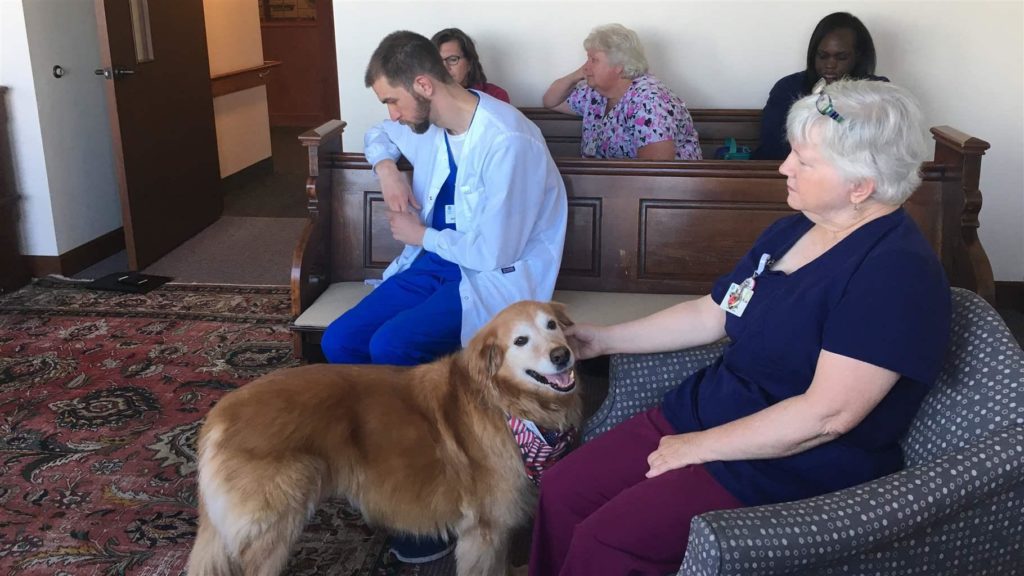
Courtesy of Laurie Henrichsen, Hospice of the Western Reserve
Shortly after the ceremony in the meditation room, Dieter slips into the room of a 75-year-old woman with advanced pancreatic cancer.
She had been readmitted two days earlier, with swelling, edema, agitation and restlessness. Dieter had administered medications to try to get the symptoms under control, although in his estimation, she was now actively dying with kidney and liver failure.
The previous day had been a bad one, so Dieter is heartened when he walks into the room and sees the tiny, white-haired woman sitting up in her bed, her eyes open and with no signs of the jerking he had observed earlier.
“I had a surprise this morning,” her husband says from an armchair at her bedside. “She’s going to hang around a little longer.” Turning to her, he says, “You’re like a cat. You have nine lives.” She doesn’t seem to follow.
Dieter pulls up a folding chair alongside the opposite side of the bed and speaks quietly to her, occasionally reaching over to pat her leg.
“I know you’re confused,” Dieter tells her. “Part of that is the medicine, part is your illness. But you’re doing better.” She smiles wanly.
Outside the room, Dieter says she could be staging a rally, a brief improvement that could buy her a little more time. Or it could be just a pause before she resumes her march to the end.
An erudite man who quotes poetry and Latin ruminations about death, Dieter has been doing this work for nearly 30 years. “Most of us will tell you that we get more from our work than we give,” he said. “For me, it’s a way of having my soul and my role aligned.” Hospice care, he said, has taught him not to hold on to resentments and to try to find joy in the everyday.
The work, Dieter says, does not sadden him. “If I felt helpless to impact how people experience the end of their lives, it would be awful. The fact that I and our team can do something about it, that’s what carries you through. You lean into it, knowing that your skills and presence are making a difference.”
‘God’s Waiting Room’
Others speak of how the work enriches their lives. “I was the biggest chicken in the world about death before I came here,” said Audrey Boylan, 51, a hospice nursing assistant in the Simpson hospice. “Now, thanks to [her patients], I’m not afraid at all. It’s an honor to sit there and hold their hands. To help them find peace and comfort. I consider this God’s waiting room.”
Once, early on, she and a volunteer were bathing an elderly woman when the volunteer nodded toward the woman’s feet. Boylan saw the familiar mottling of the skin that precedes death. As they watched, the mottling climbed up the woman’s leg, then torso and all the way up to her ear. “Can you call my kids and tell them I don’t feel too good?” the woman asked. She died that night, after her family held a Christmas celebration for her. In July.
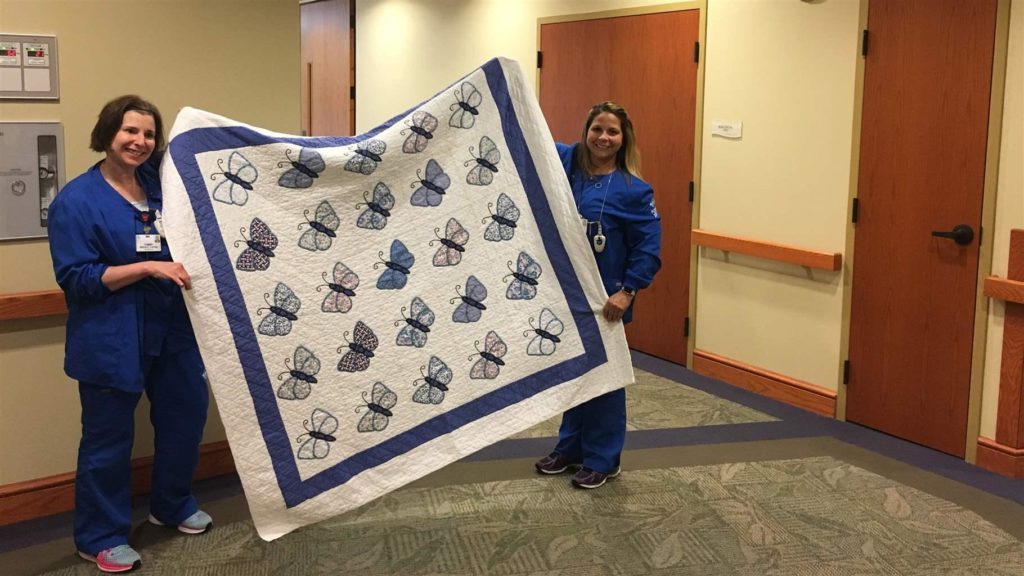
The Pew Charitable Trusts
Linda Cotoam, 69, a United Methodist pastor for 26 years and spiritual care coordinator at the Western Reserve hospice house in Westlake for the last six, said that her hospice work has broadened her faith in a way her previous 20 years in the church had not. “I got a wider view of who God’s people are, a wider view of God as much more accepting.”
Although Western Reserve is in no way religiously associated, virtually everyone interviewed for this story described themselves as, if not religiously observant, spiritually inclined.
“This job will confirm any faith you have, but it will also challenge those beliefs when you see the suffering some go through,” said Misty Durbin, 42, a social worker in the Westlake hospice. “To do this work, you need something, whether it is prayer or nature or meditation.”
With Gallagher’s prodding, the staff is quite intentional about what she calls self-care, ways to replenish themselves so they can remain mentally engaged in the work. It is vital, she says, that workers not suppress their feelings, but find ways to process and share them with others.
One of the primary dangers is “compassion fatigue,” a numbing to the suffering of others frequently experienced by caregivers. The signs are increased irritability, a dread of going to work, an inability to experience joy, and often an increased use of alcohol or drugs. Another sign, Gallagher says: “Depersonalized language, like referring to a patient by diagnosis rather than using their name.”
Western Reserve offers programs to help the staff cope, such as yoga and reiki sessions. Employees are encouraged to find peers they can confide in. And workers develop their own activities to acknowledge the meaning of their jobs, such as the ceremonies in the meditation room, which Dieter inaugurated when he came to Western Reserve three years ago. “In honoring their lives, it brings us closure,” says Jill Rossman, 55, a hospice nurse, who had attended that morning’s ceremony.
The workers have devised other rituals. In one hospice house, they created a box where they leave remembrances of patients in envelopes that are never opened. At one satellite office, staffers string cut-out figures from a twine running from wall to wall along the ceiling, each figure representing a newly deceased patient. One year it was butterflies, another stars and moons. This year it’s doves. Already there are three full rows of them.
Most say they replenish themselves in ordinary activities, clearing their minds during the drive home, gardening, listening to music, praying. A high percentage of those interviewed have dogs. Most say they do not go to their patients’ funerals, wanting to maintain a solid boundary between an empathetic professional relationship and a personal friendship.

On the other hand, Heidi Barham, 54, another pastor and spiritual care coordinator whose patients are usually in nursing homes or hospitals, sometimes conducts funerals at the request of families. “To me, it’s a way to bring families peace and comfort and the message that there’s joy on the other side of this.”
Many workers say they intentionally wall off their home lives from their professional roles. Durbin says she has selected a spot halfway on her drive home, a Key Bank branch. Before she gets there, “I go through the day, grieve, feel angry, do whatever I have to do. But the rest of the way, I don’t allow any more of that. It’s, ‘What are we going to have for dinner? What are we going to do tonight?’”
‘Visioning’
What is hard to put aside, hard to dismiss, is the remarkable moments they experience with patients as death approaches. They’ve all seen patients wait for a loved one to arrive before dying, or hold off death until family members leave. To Dieter, it is an indication of something that startles outsiders. “Patients seem to have control over the moment they die.”
Not long ago, Lindsay Turk, a 32-year-old social worker who makes house calls, had an elderly patient, a devoted father with a large family who for a week had been “actively dying,” meaning that his internal organs were failing. Each time she visited, he was surrounded by family members. She gently suggested that they take a break so as not to exhaust themselves. But, she also had a hunch.
“Sure enough, he died soon after they’d left. He just couldn’t burden them with having to watch him die.”
Workers say they frequently see patients toward the end of life making routinized motions with their hands, mimicking actions that were a habitual part of their lives, such as knitting, typing or assembling factory parts.
Dying patients often speak of an impending journey. “They’ll say they’re waiting for the train or boat or bus,” Durbin says. “They’ll say they’re going home, although they don’t mean their actual home. One patient we had wanted to put his shoes on, because he knew he was leaving. Another wanted to pack his things.”
One phenomenon familiar to any experienced hospice worker is “visioning.” Usually a day or two before dying, some patients “see” deceased loved ones hovering nearby. Sometimes they gesture or speak to their visitors, and recall the meetings later. Dieter insists these are patients who are not suffering from dementia or hallucinations.
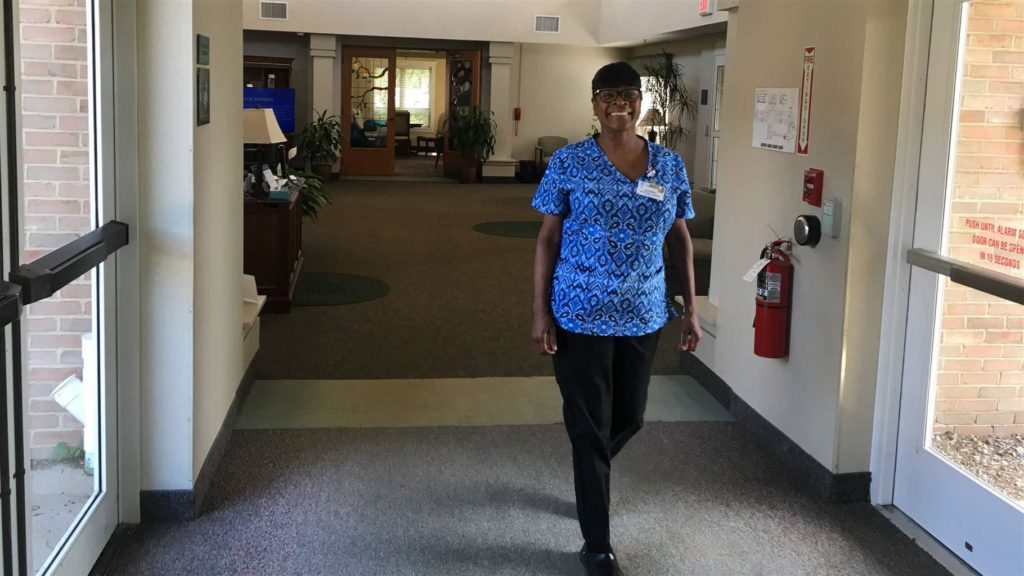
Boylan, the nurse’s assistant, recalled being in a room with a dying patient not long ago when he motioned toward something in the room. “Doesn’t your mother look beautiful in that dress,” the elderly man said to his adult daughter. His wife had died years before.
The man asked Boylan for a tie. “He wanted to look good for his wife,” she says.
On her break, Boylan drove to a nearby thrift shop and picked out a purple-and-black tie. Upon her return, she bathed the man, combed his hair and shaved him. She grasped his hand and put it to his face so he could feel how smooth his skin was. Then she dressed him in a hospital gown and tied the tie as best she could. He beamed.
“I said to him, ‘I’ll be right back, I just have to take the linen out.’”
She returned a few moments later, to find him lying back on his pillow, his eyes closed, his face relaxed.
Boylan had lost another patient. She left the hospice house that day with a smile. She had helped another on his way.
